UNDERWATER PLANTS – INVASIVE
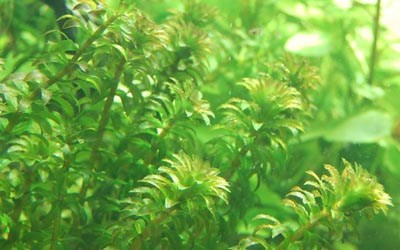
Hydrilla Hydrilla | verticillata
Hydrilla is an extremely invasive plant that is threatening to move into Michigan waters. It is vital that you learn to identify this plant and actively look for it when you’re on the water. Hydrilla is a vascular plant with true roots. The stems are slender with numerous branches and can grow up to 25 feet long. This growing pattern allows Hydrilla to form thick, dense stands that will dominate any aquatic ecosystem. The leaves are flat and pointed blades that grow in groups of four to eight that whorl around the stem. The edges of the leaves are distinctly toothed. Hydrilla can reproduce through fragmentation or sexual reproduction.
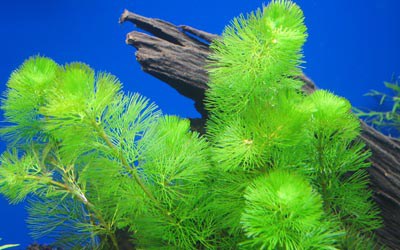
Fanwort | Cabomba caroliniana
Fanwort / Cabomba is an invasive plant and should be treated aggressively. The stems are very thin and branched and can grow up to six feet long. The leaves branch off opposite sides of the stem. The leaves have many thin, branching leaflets that form a fan shape. This plant is often misidentified as a milfoil or thin leaf pondweed.
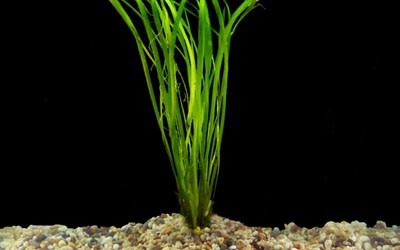
Eelgrass / Tapegrass / Wild Celery | Vallisneria Americana
Eelgrass is a vascular plant with true roots. This plant does not have a stem, but leaves that grow directly from the root crown. The leaves are long, flat, and ribbon like that grow up to three feet long and only about one centimeter wide. These plants start growing at warm water temperatures, so you may not see them until late July. They can be mechanically removed or treated with an herbicide.
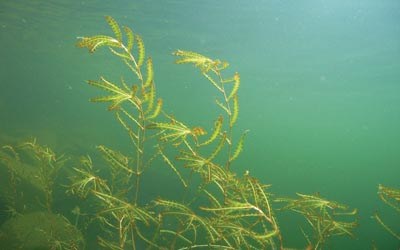
Curly Pondweed | Potamogeton crispus
Curly Pondweed is the only invasive pondweed. It is a vascular plant with true roots. The stems are about two millimeters thick and can grow up to 36 inches or longer. The leaves are all underwater and are oblong, coming to a point at the tip. The leaves are usually two to three inches long and one centimeter wide. The main identifying characteristic of Curly Pondweed is the wavy-crisped leaf edges. This plant grows very early in the season, usually dominates the ecosystem, and recedes by late-June. It is easily treated with an herbicide.

Floating Leaf Pondweeds
This is a group of pondweeds with primarily floating leaves. Some of the other pondweeds may have some floating leaves, but this group is plants that have very few underwater leaves. Species included are Floating, Longleaf, Oakes’, and American.
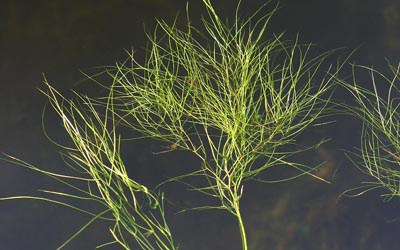
Thin Leaf Pondweeds
This is a group of pondweeds with very slender stems and leaves. In most cases, the stems and stalks are no larger than two millimeters thick. Stems and leaves vary in pattern. Species included are Alga, Threadleaf, Hill’s, Bluntleaf, Sago, Fries’, Fern, Bigsheath, Flatstem, and Vasey’s.
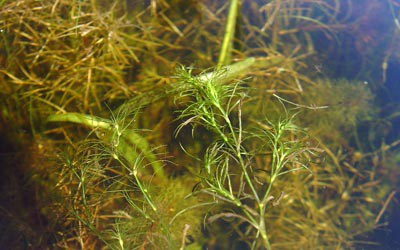
Naiads | Najas spp.
Naiads are vascular plants with true roots. The stems are wavy with slender branches. The leaves are simple and may be opposite of whorled. The main identifying characteristics is that Naiad leaves have toothed edges. These plants are commonly misidentified as pondweeds or elodea.
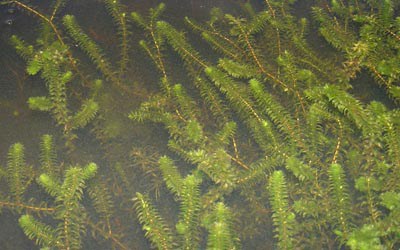
Elodea / Common Water Weed | Elodea canadensis
Elodea is a vascular plant with true roots. The stems are round in cross-section, branched, and can grow up to 3 feet long. The leaves are green and firm. On the lower portion of the stem, the leaves are paired and on opposite sides of the stem. Upper leaves are in groups of 3, whorled around the stem. These plants are commonly misidentified as pondweeds or naiads.
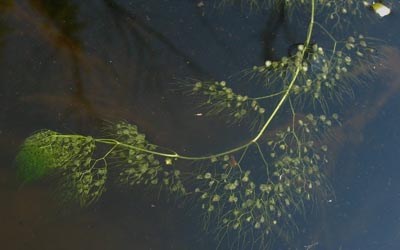
Bladderwort | Utricularia vulgaris
Bladderwort is a vascular plant without true roots. The plant’s anchor to the substrate with modified leaf structures. The stems branch and have leaves on alternate sides up to 2 inches long. The main identifying characteristic is the presence of small bladders on the leaves. These bladders are flat and green, then inflated, and turn black late in the year. This plant is commonly misidentified as a milfoil, pondweed, or fanwort.
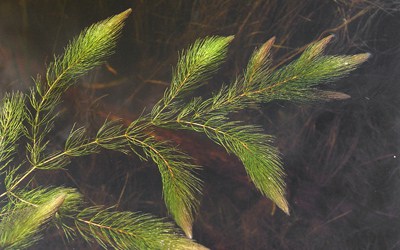
Coontail | Ceratophyllum demersum
Coontail is a vascular plant without true roots. The plants anchor to the substrate with modified leaf structures. Groups of more than 4 leaves are whorled around the stem and are crowded at the end of the stems. The leaves are stiff and forked 1 to 2 times. This plant can easily be misidentified as Chara or a milfoil.
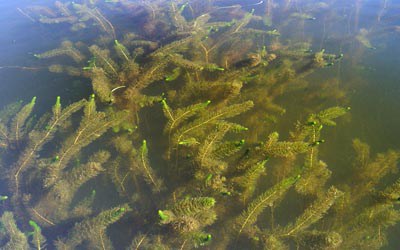
Northern Watermilfoil | Myriophyllum sibiricum
Northern Watermilfoil has many similar properties as Eurasian Watermilfoil, but Northern is one of the native species of milfoil. The leaves of Northern usually have only 5 to 10 leaflets on each side of the midrib. The spacing between leaf whorls on the stem is greatly reduced compared to Eurasian. Because of variation between plants and hybridization with other milfoils, proper identification of this plant can be difficult and may require genetic testing.
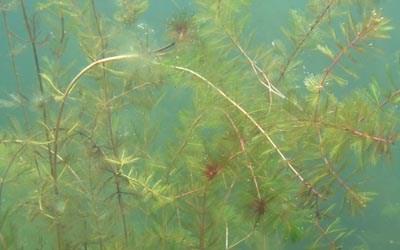
Eurasian Watermilfoil | Myriophyllum spicatum
Eurasian Watermilfoil is a vascular plant with true roots. The stems rounded with some branching. Groups of 3 or 4 leaves are whorled around the stem with spacing up to two inches between groups. Each leaf has up to 20 leaflets per side. This plant is extremely invasive because it can spread by fragmentation and sexual reproduction. Eurasian Watermilfoil should be treated with an herbicide early in the season. Because of variation between plants and hybridization with other milfoils, proper identification of this plant can be difficult and may require genetic testing.
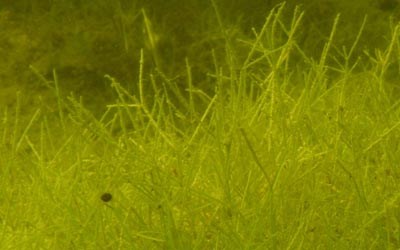
Starry Stonewort | Nitellopsis obtusa
Starry Stonewort is a multicellular algae that has many of the same characteristics of Chara (see above). Starry Stonewort is an invasive algae that can become a nuisance much more quickly than Chara. Starry Stonewort can colonize deeper waters and form thicker mats that often reach the water surface, impeding navigation and recreation.
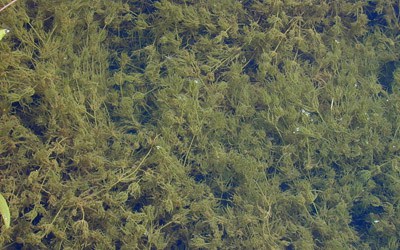
Chara / Muskgrass | Characeae spp.
Chara is a multicellular algae that resembles a vascular plant because of its stem-like and leaf-like structures. Chara can form thick, dense mats on the bottom of your waterbody. It does not have roots, but its branches grow into the sediment to form a loose connection between the colony and the bottom substrate. Chara provides essential food and habitat to other aquatic organisms. It is an efficient filter and greatly improves water quality. However, Chara can grow to a nuisance level quickly and can be tamed with algicides or mechanical removal.
